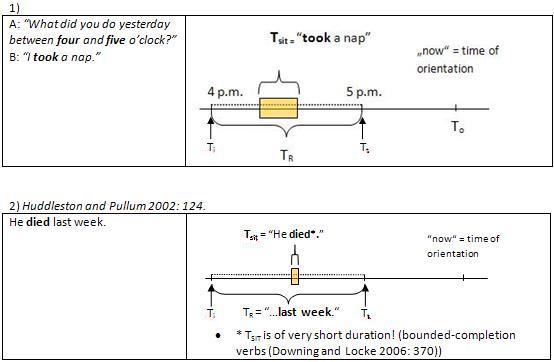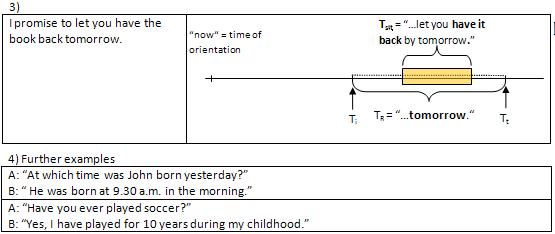Difference between revisions of "Perfective"
DavidKGray (talk | contribs) |
Volker gast (talk | contribs) |
||
| (3 intermediate revisions by 2 users not shown) | |||
| Line 1: | Line 1: | ||
| − | + | ==Definition== | |
| + | The '''perfective aspect''' is a category of [[aspect]] that contrasts with the [[imperfective aspect]]. | ||
| + | |||
| + | The '''perfective aspect''' “[views] the situation from outside, without necessarily distinguishing any of the internal structure of the situation” (Bache 1995: 269). 'Viewing a situation from outside' means focusing on the situation as a whole, i.e. in its entirety and as complete, regardless of its internal structure. Huddleston and Pullum (2002), basically adopting the model of Klein (1994), define '''perfective aspect''' by relating T<sub>R</sub> ('time referred to') to T<sub>SIT</sub> ('situational time'). Perfective aspect is accordingly defined as a property of situations in which T<sub>R</sub> entirely includes T<sub>SIT</sub> (Huddleston und Pullum 2002: 124f.). | ||
| + | |||
| + | Bache (1995: 277) provides the following formula for the perfective aspect: | ||
| + | |||
| + | :SF [T<sub>i</sub> ... T<sub>t</sub>] on Sx. | ||
| + | |||
| + | He determines SF as ‘situational focus’, T<sub>i</sub> and T<sub>t</sub> as ‘any given situation’ which must take place at a particular place and time. Applied to the example given below, T<sub>i</sub> is the beginning of TR, i.e. 4 p.m. and T<sub>t</sub> is the terminal point of T<sub>R</sub>, i.e. 5 p.m. S<sub>x</sub> is the situation described by the verb form in the declarative sentence, i.e. 'take a nap'. The situational focus (SF) is on a situation between 4 p.m. and 5 p.m., and the past tense indicates that within that period of time (TR) the situation is completed in its entirety. | ||
| + | |||
| + | Even though the perfective aspect describes 'complete' situations, the situations are not 'completed': 'The use of "completed"... puts too much emphasis on the termination of the situation, whereas the use of the perfective puts no more emphasis, necessarily, on the end of the situation than on any other part of the situation.' (Comrie 1976: 18) | ||
| + | |||
| + | ==Examples== | ||
| + | |||
| + | [[Image:Perf1.JPG]] | ||
| + | |||
| + | [[Image:Perf2.JPG]] | ||
| + | |||
| + | ==Literature== | ||
| + | |||
| + | * Bache, Carl. ''The Study of Aspect, Tense and Action.'' Frankfurt am Main: Lang, 1995. | ||
| + | * Comrie, Bernard. ''Aspect''. Cambridge: Cambridge University Press. 1976. | ||
| + | * Downing, Angela and Philip Locke. ''English Grammar: A University Course.'' 2nd edition. London: Routledge, 2006. | ||
| + | * Huddleston, Rodney D. and Geoffrey K. Pullum. ''The Cambridge Grammar of the English Language.'' Cambridge: Cambridge UP, 2002. | ||
| + | * Klein, Wolfgang. ''Time in Language.'' London: Routledge, 1994. | ||
| + | |||
| + | {{dc}} | ||
Latest revision as of 14:34, 10 February 2010
Definition
The perfective aspect is a category of aspect that contrasts with the imperfective aspect.
The perfective aspect “[views] the situation from outside, without necessarily distinguishing any of the internal structure of the situation” (Bache 1995: 269). 'Viewing a situation from outside' means focusing on the situation as a whole, i.e. in its entirety and as complete, regardless of its internal structure. Huddleston and Pullum (2002), basically adopting the model of Klein (1994), define perfective aspect by relating TR ('time referred to') to TSIT ('situational time'). Perfective aspect is accordingly defined as a property of situations in which TR entirely includes TSIT (Huddleston und Pullum 2002: 124f.).
Bache (1995: 277) provides the following formula for the perfective aspect:
- SF [Ti ... Tt] on Sx.
He determines SF as ‘situational focus’, Ti and Tt as ‘any given situation’ which must take place at a particular place and time. Applied to the example given below, Ti is the beginning of TR, i.e. 4 p.m. and Tt is the terminal point of TR, i.e. 5 p.m. Sx is the situation described by the verb form in the declarative sentence, i.e. 'take a nap'. The situational focus (SF) is on a situation between 4 p.m. and 5 p.m., and the past tense indicates that within that period of time (TR) the situation is completed in its entirety.
Even though the perfective aspect describes 'complete' situations, the situations are not 'completed': 'The use of "completed"... puts too much emphasis on the termination of the situation, whereas the use of the perfective puts no more emphasis, necessarily, on the end of the situation than on any other part of the situation.' (Comrie 1976: 18)
Examples
Literature
- Bache, Carl. The Study of Aspect, Tense and Action. Frankfurt am Main: Lang, 1995.
- Comrie, Bernard. Aspect. Cambridge: Cambridge University Press. 1976.
- Downing, Angela and Philip Locke. English Grammar: A University Course. 2nd edition. London: Routledge, 2006.
- Huddleston, Rodney D. and Geoffrey K. Pullum. The Cambridge Grammar of the English Language. Cambridge: Cambridge UP, 2002.
- Klein, Wolfgang. Time in Language. London: Routledge, 1994.

